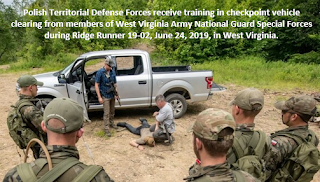U.S. Army Special Forces soldiers completed the first irregular and unconventional warfare training iteration for members of the Polish Territorial Defense Forces and Latvian Zemmessardze as a part of the Ridge Runner program in West Virginia, according to service officials. The Green Berets, who are with 2nd Battalion, 19th Special Forces Group and the West Virginia Army National Guard, use the Ridge Runner exercise to offer U.S. troops and NATO allied forces training in asymmetrical warfare.
This summer, Latvia and Poland traveled to West Virginia for the program. Both nations have newly invigorated homeland defense forces capable of pushing back against an invading force and opposing a potential occupation. The units are trained to provide response during the early stages of a hybrid conflict. Their tasks could include slowing the advancing units of an aggressor nation by destroying key transportation infrastructure such as bridges, attacking enemy forces at choke points and potentially serving as forward observers for NATO aircraft responding with airstrikes.
Polish Territorial Defense Forces, for instance, typically have a role similar to that of the U.S. National Guard, supporting local communities and acting as a reserve base for conventional forces. “Here at Ridge Runner, we developed skills beyond that,” said Marek Zaluski, a public information officer for the Polish troops, in an Army news release. "We’ve learned how to work with Special Forces, serve as liaisons, how to speak the same language, have the interoperability and cooperation.”
U.S. special operations forces have been training more with allies from the Baltic states and other Eastern European nations in the wake of the annexation of Crimea by the Russian Federation in 2014. A low-level conflict continues to simmer in eastern Ukraine’s Donbas region between Russian-backed separatists and government forces to this day. The conflict spurred the Baltics into action, as Lithuania, Latvia and Estonia embraced the concepts of total defense and unconventional warfare, combining active-duty, national guard and reserve-styled forces to each take on different missions to resist Russian aggression and even occupation. Poland similarly established its Territorial Defense Forces in 2017 to address homeland integrity concerns and tensions with Russia.
To solidify those gains, the U.S. military should provide more advanced equipment, help to develop resistance plans, build fusion centers for intelligence collection and counter Russian disinformation and cyber warfare, according to Stephen J. Flanagan, a senior political scientist at the Rand Corporation who co-authored a study on deterring Russian aggression for the Pentagon. “Our general assessment is we don’t believe, and many of the Baltic leaders don’t believe, that the Russians would make a land grab and sue for peace,” Flanagan told Army Times in April. “But they are opportunistic. If they think they can cause a crisis in NATO and make NATO look feckless or unable to respond quickly, that may be something they would risk.”
Interoperability between U.S. troops and European forces would be critical in the event of an attack on a NATO ally. Troops would need to share tactics, use similar terms and phrases over the radio waves and understand the flow of calling in close-air support in order to cooperate on the battlefield. Even when partner forces can speak English exceptionally well, they may not be familiar with American military jargon until they train with U.S. troops and bring those terms back to their home units.
“The soldiers who came with us for this exercise were specifically handpicked from a larger group because they represent the skills needed to operate with the Special Forces community as liaisons, pathfinders, and as people who are the points of contact in case of an unconventional warfare situation," Zaluski said in the release. The Ridge Runner program taps into roughly 500,000 acres of public and private land in West Virginia.
The training incorporates local government, law enforcement, emergency services and has utilized fixed wing and rotary aircraft in past exercises. “The conclusion of this Ridge Runner training is an exceptionally important milestone for both West Virginia and our allies in Poland and Latvia, who we have a longstanding relationship within our state through the State Partnership Programs with the Illinois and Michigan National Guards,” said West Virginia National Guard Adjutant General Maj. Gen. James Hoyer, in the release.
The State Partnership Program is administered by the National Guard Bureau with the Defense Department and State Department’s policy goals in mind. The initiative links state Guard units with partner countries for various training opportunities in the continental United States and overseas. The Illinois National Guard, for instance, is partnered with Poland, while the Michigan National Guard is partnered with Latvia. “West Virginia is the perfect venue for our highly trained special forces to help these two nations’ military forces develop the skills vital to their mission at home, which is extraordinarily important in this era of geo-political uncertainty," Hoyer added.
Article from the Army Times


No comments:
Post a Comment
Enter your Comments below. Keep it clean.